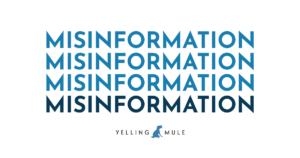The Spread of False Information on Social Media
What is misinformation? Misinformation is false or misleading information; this varies from disinformation which is deceptive information that is purposefully harmful and spread. Social media algorithms can amplify misinformation and have the false information reach more people than the truth. Steven Lee Myers (2022) describes how “new analysis found that algorithms and some features of social media sites help false posts go viral”
Fact-Checking
Leading up to the 2016 U.S. presidential election, large amounts of misinformation about candidates, policy, and voting were being shared online. Following these events, media literacy training and content labels became widespread in efforts to educate people about misinformation. Social media platforms began to feel pressure and criticism from the public to update their fact-checking procedures. Most platforms utilize third-party fact-checkers, artificial bots, and users like you reporting suspicious or inappropriate content. Meta shares how in efforts to notify the community about potential misinformation they utilize “third-party fact-checkers … and display a clear label to warn people that the content has been rated as “False, Altered, or Partly False”. These were some of the early steps taken to address viral misinformation and alert the platform’s users.
New Risks Today
In 2023, there are many new risks in the spread of misinformation. According to the New York Times, artificial intelligence programs can create deceptive images as well as provide people with mass-produced falsehoods through ChatGPT. Artificial intelligence has expanded beyond words and images into the video space making deepfakes. Deepfakes are videos that utilize artificial intelligence to gather previous videos to create a fictional clip of a person to make it appear that they are saying something that they never have.
The endless scrolling capability of TikTok allows users to be exposed to extremism and conspiracy theories at any point. While, privately encrypted messaging platforms, like WhatsApp and Telegram, have allowed more dangerous content to be sent because the channels are more difficult to trace.
Protective Legislation
The European Union ratified the Digital Service Act to force social media platforms to adopt new policies or update their algorithm in efforts against misinformation. This law targeted large platforms and search engines with more than 45 million monthly users to address the companies that can impact and seriously harm individuals if not updated.
This includes 19 brands: Alibaba AliExpress, Amazon Store, Apple App Store, Booking.com, Facebook, Google Play, Google Maps, Google Shopping, Instagram, LinkedIn, Pinterest, Snapchat, TikTok, Twitter, Wikipedia, YouTube, Zalando, Bing, Google Search.
The consequence for platforms that do not stay compliant with the Digital Service Act is facing fines of up to six percent of their organization’s revenue. After Europe updates in legislation, this movement continues beyond the continent and into the United States.
Detecting Misinformation
Here are some tips to help you recognize whether or not a post on social media is misinformation or not. Start by checking to see if the references listed are accredited and trustworthy sources. Then make sure the sources are consistent and make the claims the post is referring to. Be suspicious of content that uses very emotional language and sensationalism, this may be a sign of misinformation.
Combating Misinformation
The best course of action regarding combating misinformation:
- Consider taking a digital literacy or media literacy course
- Be responsible for sharing and engaging on social media
- Report false information to platforms
- Create a strategy for your businesses to protect their online reputation
Yelling Mule is always here to assist you if you have any questions or concerns about misinformation.


